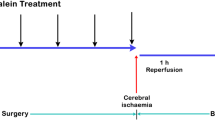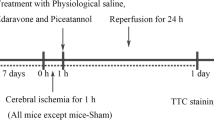Summary
Ischemic stroke leads to high potentiality of mortality and disability. The current treatment for ischemic stroke is mainly focused on intravenous thrombolytic therapy. However, ischemia/ reperfusion induces neuronal damage, which significantly influences the outcome of patients with ischemic stroke, and the exact mechanism implicated in ischemia/reperfusion injury remains unclear, although evidence shows that oxidative stress is likely to be involved. Betulinic acid is mainly known for its anti-tumor and anti-inflammatory activities. Our previous study showed that betulinic acid could decrease the reactive oxygen species (ROS) production by regulating the expression of NADPH oxidase. Thus, we hypothesized that betulinic acid may protect against brain ischemic injury in the animal model of stroke. Focal cerebral ischemia was achieved by using the standard intraluminal occlusion method and reperfusion enabled after 2 h ischemia. Neurological deficits were scored. Infarct size was determined with 2,3,5-triphenyltetrazolium chloride monohydrate (TTC) staining and the mRNA expression of NADPH oxidase 4 (NOX4) was determined by RT-PCR in infarct tissue. ROS generation and apoptosis in ischemic tissue were analyzed by measuring the oxidative conversion of cell permeable 2’,7’-dichloro-fluorescein diacetate (DCF-DA) to fluorescent dichlorofluorescein (DCF) in fluorescence microplate reader and TUNEL assay, respectively. In Kunming mice, 2 h of middle cerebral artery (MCA) occlusion followed by 24 or 72 h of reperfusion led to an enhanced NOX4 expression in the ischemic hemisphere. This was associated with elevated levels of ROS generation and neuronal apoptosis. Pre-treatment with betulinic acid (50 mg/kg/day for 7 days via gavage) prior to MCA occlusion prevented the ischemia/reperfusion-induced up-regulation of NOX4 and ROS production. In addition, treatment with betulinic acid could markedly blunt the ischemia/reperfusion-induced neuronal apoptosis. Finally, betulinic acid reduced infarct volume and ameliorated the neurological deficit in this stroke mouse model. Our results suggest that betulinic acid protects against cerebral ischemia/reperfusion injury in mice and the down-regulation of NOX4 may represent a mechanism contributing to this effect.
Similar content being viewed by others
References
Eshah NF. Lifestyle and health promoting behaviours in jordanian subjects without prior history of coronary heart disease. Int J Nurs Pract, 2011,17(1):27–35
Suda S, Katsumata T, Okubo S, et al. Low serum n-3 polyunsaturated fatty acid/n-6 polyunsaturated fatty acid ratio predicts neurological deterioration in Japanese patients with acute ischemic stroke. Cerebrovasc Dis, 2013,36(5-6): 388–393
Margaill I, Plotkine M, Lerouet D. Antioxidant strategies in the treatment of stroke. Free Radic Biol Med, 2005,39(4):429–443
Appelros P, Jonsson F, Asberg S, et al. Trends in stroke treatment and outcome between 1995 and 2010: Observations from riks-stroke, the swedish stroke register. Cerebrovasc Dis, 2014,37(1):22–29
Koga M, Arihiro S, Miyashita F, et al. Factors associated with early recanalization failure following intravenous rt-pa therapy for ischemic stroke. Cerebrovasc Dis, 2013,36(4): 299–305
Thomas SR, Witting PK, Drummond GR. Redox control of endothelial function and dysfunction: Molecular mechanisms and therapeutic opportunities. Antioxid Redox Signal, 2008,10(10):1713–1765
Chrissobolis S, Faraci FM. The role of oxidative stress and nadph oxidase in cerebrovascular disease. Trends Mol Med, 2008,14(11):495–502.
Bedard K, Krause KH. The NOX family of ROS-generating NADPH oxidases: physiology and pathophysiology. Physiol Rev, 2007,87(1):245–313
Chen H, Yoshioka H, Kim GS, et al. Oxidative stress in ischemic brain damage: mechanisms of cell death and potential molecular targets for neuroprotection. Antioxid Redox Signal, 2011,14(8):1505–1517
Nayernia Z, Jaquet V, Krause KH. New insights on NOX enzymes in the central nervous system. Antioxid Redox Signal, 2014,20(17):2815–2837
McCann SK, Roulston CL. NADPH oxidase as a therapeutic target for neuroprotection against ischaemic stroke: future perspectives. Brain Sci, 2013,3(2):561–598
Serrano F, Kolluri NS, Wientjes FB, et al. Nadph oxidase immunoreactivity in the mouse brain. Brain Res, 2003,988(1-2):193–198
Qin YY, Li M, Feng X, et al. Combined NADPH and the NOX inhibitor apocynin provides greater anti-inflammatory and neuroprotective effects in a mouse model of stroke. Free Radic Biol Med, 2017,104:333–345
Walder CE, Green SP, Darbonne WC, et al. Ischemic stroke injury is reduced in mice lacking a functional nadph oxidase. Stroke, 1997,28(11):2252–2258
Radermacher KA, Wingler K, Langhauser F, et al. Neuroprotection after stroke by targeting nox4 as a source of oxidative stress. Antioxid Redox Signal, 2013,18(12): 1418–1427
Kleinschnitz C, Grund H, Wingler K, et al. Post-stroke inhibition of induced nadph oxidase type 4 prevents oxidative stress and neurodegeneration. PLoS Biol, 2010, 8(9):e1000479
Mullauer FB, Kessler JH, Medema JP. Betulinic acid, a natural compound with potent anticancer effects. Anticancer Drugs, 2010,21(3):215–227
Lu Q, Xia N, Xu H, et al. Betulinic acid protects against cerebral ischemia-reperfusion injury in mice by reducing oxidative and nitrosative stress. Nitric Oxide, 2011,24(3): 132–138
Jiao S, Zhu H, He P, et al. Betulinic acid protects against cerebral ischemia/reperfusion injury by activating the PI3K/Akt signaling pathway. Biomed Pharmacother, 2016,84:1533–1537
Förstermann U, Li H. Therapeutic effect of enhancing endothelial nitric oxide synthase (eNOS) expression and preventing eNOS uncoupling. Br J Pharmacol, 2011,164(2): 213–223
Asahi M, Asahi K, Wang X, et al. Reduction of tissue plasminogen activator-induced hemorrhage and brain injury by free radical spin trapping after embolic focal cerebral ischemia in rats. J Cereb Blood Flow Metab, 2000,20(3):452–457
Bederson JB, Pitts LH, Tsuji M, et al. Rat middle cerebral artery occlusion: Evaluation of the model and development of a neurologic examination. Stroke, 1986,17(3):472–476
Kahles T, Luedike P, Endres M, et al. Nadph oxidase plays a central role in blood-brain barrier damage in experimental stroke. Stroke, 2007,38(11):3000–3006
Zhang X, He F, Yang J, et al. Protective effects of epigallocatechin-3-gallate on intestinal ischemia reperfusion injury through enhanced activation of PI3K/Akt pathway in rats. J Huazhong Univ Sci Technolog Med Sci, 2015,35(3):378–38325
Infanger DW, Sharma RV, Davisson RL. Nadph oxidases of the brain: Distribution, regulation, and function. Antioxid Redox Signal, 2006,8(9-10):1583–1596
Carbone F, Teixeira PC, Braunersreuther V, et al. Pathophysiology and treatments of oxidative injury in ischemic stroke: Focus on the phagocytic NADPH oxidase 2. Antioxid Redox Signal, 2015,23(5):460–489
McCarty MF. NADPH oxidase activity in cerebral arterioles is a key mediator of cerebral small vessel disease-Implications for prevention. Healthcare (Basel), 2015,3(2):233–251
Takac I, Schroder K, Zhang L, et al. The e-loop is involved in hydrogen peroxide formation by the nadph oxidase nox4. J Biol Chem, 2011,286(15):13304–13313
Miller AA, Drummond GR, Schmidt HH, et al. Nadph oxidase activity and function are profoundly greater in cerebral versus systemic arteries. Circ Res, 2005,97(10): 1055–1062
Aldieri E, Riganti C, Polimeni M, et al. Classical inhibitors of noxnad(p)h oxidases are not specific. Curr Drug Metab, 2008,9(8):686–696
Gray SP, Jha JC, Kennedy K, et al. Combined NOX1/4 inhibition withGKT137831 in mice provides dose-dependent reno-and atheroprotection even in established microand macrovascular disease. Diabetologia, 2017,60(5):927–937
Steinkamp-Fenske K, Bollinger L, Voller N, et al. Ursolic acid from the chinese herb danshen (salvia miltiorrhiza l.) upregulates enos and downregulates nox4 expression in human endothelial cells. Atherosclerosis, 2007,195(1): e104–111
Vallet P, Charnay Y, Steger K, et al. Neuronal expression of the nadph oxidase nox4, and its regulation in mouse experimental brain ischemia. Neuroscience, 2005,132(2): 233–238
Ma MW, Wang J, Zhang Q, et al. NADPH oxidase in brain injury and neurodegenerative disorders. Mol Neurodegener, 2017,12(1):7
Alakurtti S, Makela T, Koskimies S, et al. Pharmacological properties of the ubiquitous natural product betulin. Eur J Pharm Sci, 2006,29(1):1–13
Author information
Authors and Affiliations
Corresponding author
Rights and permissions
About this article
Cite this article
Lu, P., Zhang, Cc., Zhang, Xm. et al. Down-regulation of NOX4 by betulinic acid protects against cerebral ischemia-reperfusion in mice. CURR MED SCI 37, 744–749 (2017). https://doi.org/10.1007/s11596-017-1798-5
Received:
Revised:
Published:
Issue Date:
DOI: https://doi.org/10.1007/s11596-017-1798-5




